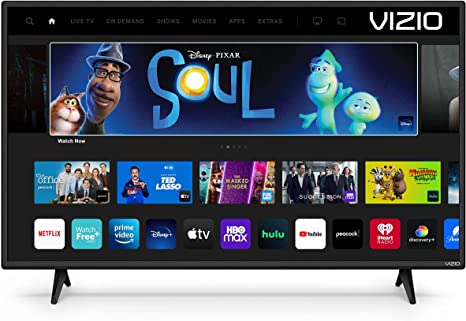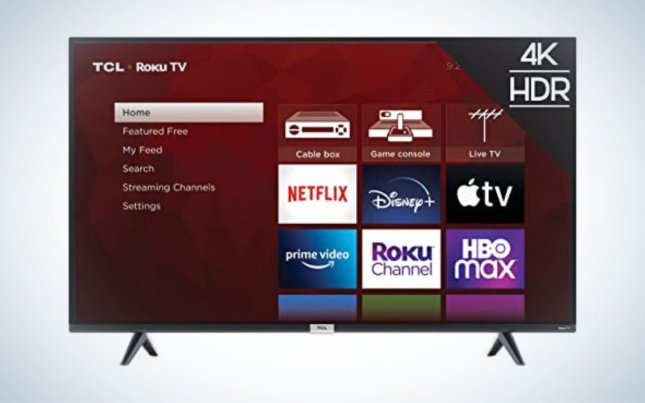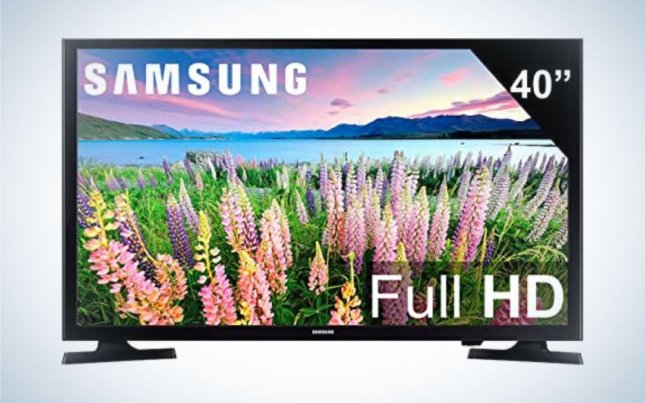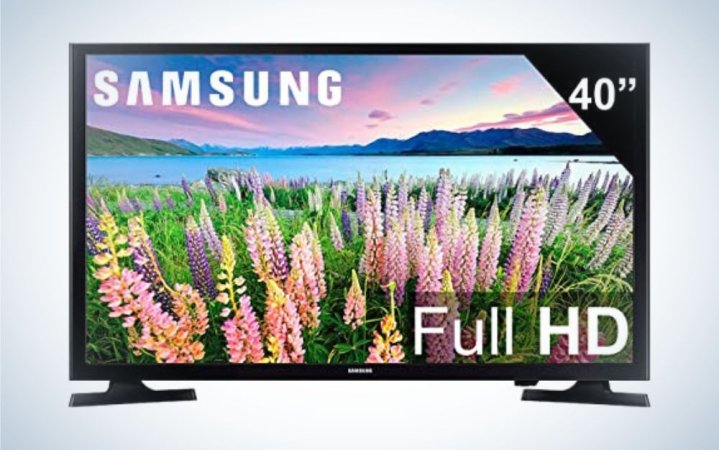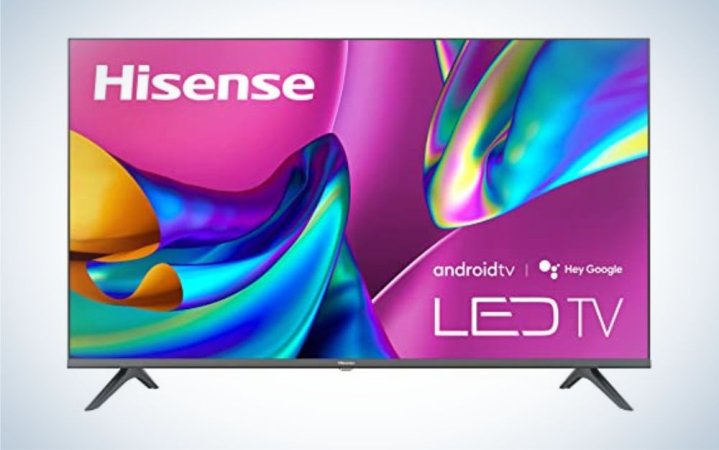We may earn revenue from the products available on this page and participate in affiliate programs. Learn more ›
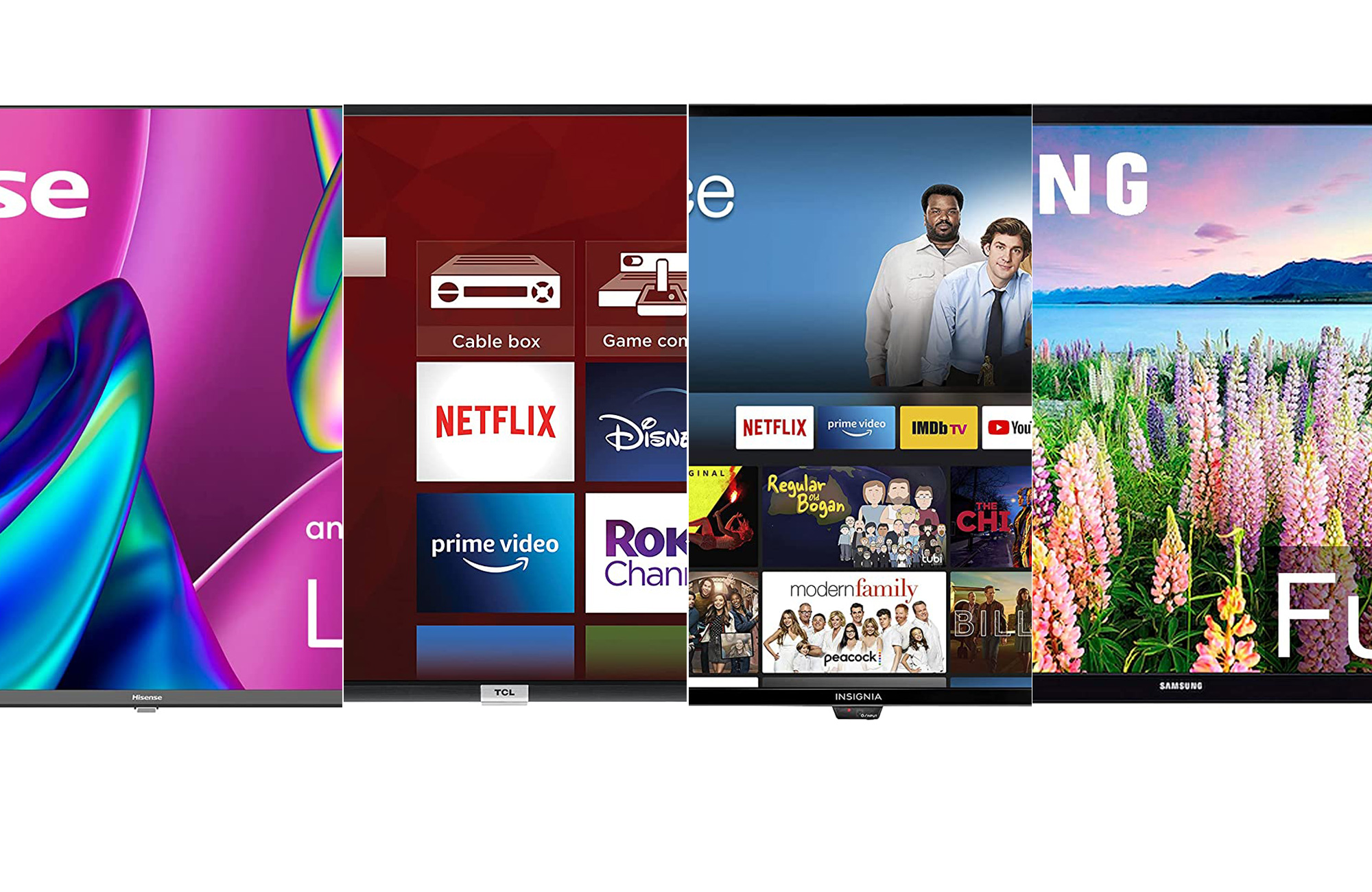
Just a few years ago, the best TVs under $300 weren’t much to write home about. You could get the tiny plasma TV Michael Scott had on the wall of his condo in The Office. The TV experience has, by and large, gotten more accessible and affordable in the past few years, with many options available that provide nice upgrades without demanding staggering financial commitments. It comes down to understanding what kinds of bells and whistles you want (or are willing to do without), the size of the space you’re looking to fill, brands you like, and other key factors—each of which will help you narrow your search and ensure you find exactly what you’re looking for. Here’s how to get the best TVs for under $300.
- Best overall: TCL UHD Smart LED TV
- Best all-in-one: Amazon Fire TV
- Best for sound quality: Insignia NS-42F201NA22
- Best for smaller spaces: Samsung UN40N5200AFXZA
- Best for streaming: Hisense 43A6G
- Best budget: Vizio D-Series
How we chose the best TVs under $300
We narrowed down our choices for the best TVs under $300 by reviewing product specifications, personal experiences, peer suggestions, professional reviews, and user impressions, then we selected our picks by carefully evaluating each product based on the following criteria:
- Reputation of the manufacturer: Is the brand well-known and respected in the field of TVs?
- Image quality: 4K is increasingly attainable at this price point
- Versatility: Do these TVs give you options as to how you mount or display them?
- Entertainment offerings: Is this just a TV, or is it a smart TV platform capable of accessing various streaming, music, and gaming apps?
- Price: Is the price fair?
- Customer reviews: How have customers rated the product?
The best TVs under $300: Reviews & Recommendations
Best overall: TCL UHD Smart LED TV
Best overall
Pros
- Full 4K display
- Roku streaming built-in
- Voice-controlled searching
- Lots of I/O: 3 HDMI 2.0 with HDCP 2.2 (one with HDMI ARC), 1 USB, Composite, Headphone Jack, Optical Audio Out inputs
- Easy to use, right out of the box
Cons
- Attachable legs can be wobbly and unstable
Why it made the cut: TCL has a reputation for delivering top-tier picture quality without exorbitant prices, making them a great entry point for those looking to upgrade without a lot of hassle.
Specs
- Weight: 16.5 pounds
- Dimensions: 38.2 x 22.4 x3 inches without stand; 38.2 inches x 24.5 inches x 7.6 inches with stand
- Screen size: 43”
TCL has a strong reputation for delivering TVs that provide quality imagery upgrades without costing huge amounts of money. The company’s Roku smart TVs will have even a novice set up and streaming right out of the box, with only a Wi-Fi connection needed. Its multiple HDMI and USB inputs, as well as other ports, make it flexible with multiple devices and allow you to make subtle improvements (such as by adding a soundbar, which is recommended).
If you have the ability or option to mount the TCL, that may be a preferable route to take as the legs (which easily screw on the bottom of the unit) often feel a little unstable, and could be risky on narrow TV stands. But with a voice-control remote and endless streaming options available through the internal Roku, it’s a great option for the budding cord-cutter and for instant family movie nights.
Best all-in-one: Amazon Fire TV
Best all-in-one
Pros
- Supports 4K Ultra HD, HDR 10, HLG, and Dolby Digital Plus
- 4 HDMI ports (3 HDMI 2.0 + 1 HDMI eARC 2.1)
- Remote can sync with Amazon Alexa
- Dolby Digital Plus speakers
Cons
- Can lose sharpness in brightly-lit rooms
- Blue “standby” LED light cannot be turned off
Why it made the cut: The phrase “most bang for your buck” gets thrown around a lot, but it really does apply to this affordable 4K TV that brings decent screen size, dynamic resolution, and flexible entertainment options.
Specs
- Weight: 15 pounds without stand
- Dimensions: 38.1 x 22.3 x 3.5 inches without stand
- Screen size: 43”
The Amazon Fire TV is designed to be the focal point of a smart home. Its HDMI 2.1 port makes it compatible with higher-resolution sources and its ability to sync with Alexa allows for voice-control options, while it can also wirelessly connect to Echo speakers for a nice audio boost—all of which make it well-suited for movies, gaming, as well as music streaming. It’s an all-in-one entertainment option at a great price.
It should be noted, though, that brighter rooms can dilute the TV’s darker areas, turning what should be sharp blacks into more gray, and users have complained about the omnipresent LED light that never seems to turn off, which can be a concern if you’d rather your family room wasn’t constantly bathed in blue. But overall this is a versatile and functional entertainment unit that, for under $300, outperforms its price tag.
Best for sound quality: Insignia NS-42F201NA22
Best for sound quality
Pros
- Built-in DTS TruSurround audio complements the 1080p LCD display
- Alexa voice-enabled search
- Smart home compatible
- 2 HDMI ports (1 ARC)
Cons
- Fire TV OS can freeze with unstable or weak Wi-Fi connection
Why it made the cut: Typically, lower-priced TVs sacrifice the audio … but not in the case of this affordable Insignia screen.
Specs
- Weight: 20.2 pounds
- Dimensions: 37.4 x 23.5 x 8.7 inches
- Screen size: 42”
Finding a lower-priced television that can provide you with decent enough sound to make the purchase of a soundbar or external speakers a luxury you won’t necessarily need isn’t easy, which is why Insignia makes the list. Its built-in DTS TruSurround audio won’t blow your eardrums out, but it’s a lot better than a lot of televisions in the same size and price range.
The Insignia provides a solid, if not spectacular, 1080p HD viewing experience, while the pre-installed Fire TV app makes syncing with other Amazon devices, such as Alexa or Echo speakers, extremely intuitive and user-friendly. However, if you are not an Amazon Prime member, you may find the TV’s insistence that you log in (and its constant surfacing of content you need to pay extra for) a little annoying.
Best for smaller spaces: Samsung UN40N5200AFXZA
Best for smaller spaces
Pros
- Sharp PurColor 1080p image
- Mico-dimming technology helps enhance shadows and contrasts
- Can work with SmartThings app to sync with other smart home devices
Cons
- Some limitations on streaming app availability
- Image can depend on the strength or stability of the Wi-Fi connection
Why it made the cut: Samsung is, obviously, a known and trusted name when it comes to TVs, so it’s not surprising that they deliver a lower-priced, lower-sized option that still delivers a sharp picture and smart TV capabilities.
Specs
- Weight: 15.9 pounds
- Dimensions: 36.3 x 20.9 x 2.9 inches without stand
- Screen size: 40”
Sometimes you just need solid and dependable. Luckily, this Samsung offers both. Although it doesn’t bring a flashy 4K display and a lot of bells and whistles of the brand’s QLED flagships, it does have a sharp, dynamic 1080p display with surprisingly crisp colors and details, and its hardware—both leg stands and wall-mounts—ensure it’ll fit easily into smaller areas like bedrooms or offices.
It may not have every single streaming platform (customers have complained that, for example, Hulu is not a compatible platform at the moment), it does have a large range of pre-installed apps as well as nearly 50 additional apps available for download ranging from free to subscription-based.
Best for streaming: Hisense 43A6G
Best for streaming
Pros
- Motion Rate 120 image processing automatically adjusts the 1080p FHD LCD screen for high-speed broadcasts
- “Game mode” helps cut down on lag during video game play
- Android TV enabled
Cons
- Heavy
Why it made the cut: The Hisense was made with fast-paced sports action in mind, and delivers clear visuals optimized to take full advantage of any live broadcast no matter what game you’re in to.
Specs
- Weight: 19.16 pounds
- Dimensions: 42 x 25 x 5 inches
- Screen size: 43”
The Hisense TV is designed with games—both watching and playing—in mind, and caters to those looking to switch seamlessly between a live sports broadcast on TV and an in-game meet in your favorite console game. Its Motion Rate 120 image processing software promises smooth, high-speed visuals, without lag or blur, so you never miss a beat. Colors are bright and crisp and true, and the built-in Dolby audio speakers are surprisingly effective.
This is generally a pretty rock solid TV, even if you’re not the world’s biggest sports fan. The only real issue might be that it’s about 5 pounds heavier than other, similar TVs in this size and price range, which could impact where you mount or stand it. Otherwise, this is a solid contender.
Best budget: Vizio D-Series
Best budget
Pros
- Full 1080p display
- Built-in Smart TV technology
- “V-Gaming Engine,” which means that the monitor optimizes picture mode for gaming automatically
Cons
- Built-in speaker quality is weak
- Image can be choppy with weak or unreliable Wifi connections
Why it made the cut: An all-around solid 32-inch TV for the price, featuring Vizio’s SmartCast technology that allows for streaming without any additional hardware needed and a bright backlit LED display.
Specs
- Weight: 8.99 pounds
- Dimensions: 28.59 x 4.66 x 19.02 inches
- Screen size: 32”
Featuring a lightweight construction and sharp image even at 32 inches, the Vizio is a decent all-around option if you’re looking for an affordable smart TV. With just an internet connection, you can get a lot of the experience, including instant access to channels such as Netflix, Disney+, and Hulu (with subscriptions, of course). The sound quality is a little subpar and could benefit from a boost courtesy of external speakers or a soundbar.
The automatic adjustment to gaming mode is a selling point for those who anticipate flipping between TV viewing and consoles repeatedly, or for those looking for a primary gaming hub. Lag can be an issue, though, so ensure you have the Vizio connected to a strong, reliable Wi-Fi connection.
What to consider before buying one of the best TVs under $300
Let’s start off with one very important reality: In the under-$300 price range, you’re not going to have unlimited options. That said, you will still have some choices among the best TVs under $300 when it comes to size and resolution, which are the two biggest considerations when investing in a new TV.
Resolution
There are really only two options you need to consider when looking for an HD TV in this price range: HD/1080p or 4K. HD/1080p TVs are ideal if you’re looking for a TV that is 32 inches or smaller. At that size, you’ll get a crisp, clear 1920×1080 pixel image and won’t want for the extra boost you’d get from 4K. When you get into the 50-inches to 55-inches range, however, this is where you’ll want to opt for 4K to get the best picture possible, with its 3840×2160 pixel image. No, you won’t find OLED technology at this price point, but that doesn’t mean you won’t get a compelling picture from one of the best TVs under $300.
Size and space
Size consideration extends beyond just wall space and the desire to have the most eye-popping presentation possible. You need to consider, in tandem, the space of the room where the TV will live, in order to judge the proper seating distance from it to ensure optimal (and healthy) viewing.
- For a 32-inch TV, you’ll want to sit about 2 ½ to 4 feet away at 4K (2 ½ feet at 1080p)
- For a 40-inch TV, you’ll want to sit about 3 to 3 ½ feet away at 4K (5 feet at 1080p)
- For a 50-inch TV, you’ll want to sit about 4 to 6 1/2 feet away at 4K (6 1/2 feet at 1080p)
- For a 60-inch TV, you’ll want to sit about 5 to 7 1/2 feet away at 4K (7 1/2 feet at 1080p)
Use
Your TV usually has to pull double- and triple-duty these days, so you’ll also need to consider whether you’ll be streaming vs. watching via cable hook-up (which may necessitate purchasing an add-on streaming device, like an Apple TV 4K, if you select a non-smart TV), whether you’ll be gaming, and how many devices you expect to have plugged in at one time.
FAQs
No, you don’t. While smart TVs make things easier by having the streaming capability built in, you can stream through a number of attachable devices (almost all via USB, which most monitors and TVs should have), such as a Roku, Apple TV, Google Chromecast, Amazon Fire Stick, or even your PlayStation 5 or Xbox Series X game console.
There is a broad range here, mostly because a lot of it comes down to variables such as how often it’s used, how long it’s typically left on, and how well it’s maintained, but the average lifespan of a television varies between 4 and 10 years, or approximately 40,000-100,000 hours.
Certainly. For one, they are largely dependent on your internet connection, so a weak signal or a busy network can result in reduced image quality or lack of access to channels and streaming platforms. They can also “crash” like a computer, which can necessitate either annoying reboots and restarts or, at worst, repairs. Also, like any network-connected device, “smart TVs” have more security risks inherent than a standard TV.
Final thoughts on the best TVs under $300
A great viewing experience can be had for a relatively low cost, with the price of HD technology having come down to more accessible levels in recent years. Knowing exactly what you want also goes a long way toward pinpointing the best TVs under $300 and the one that’s right for you.
